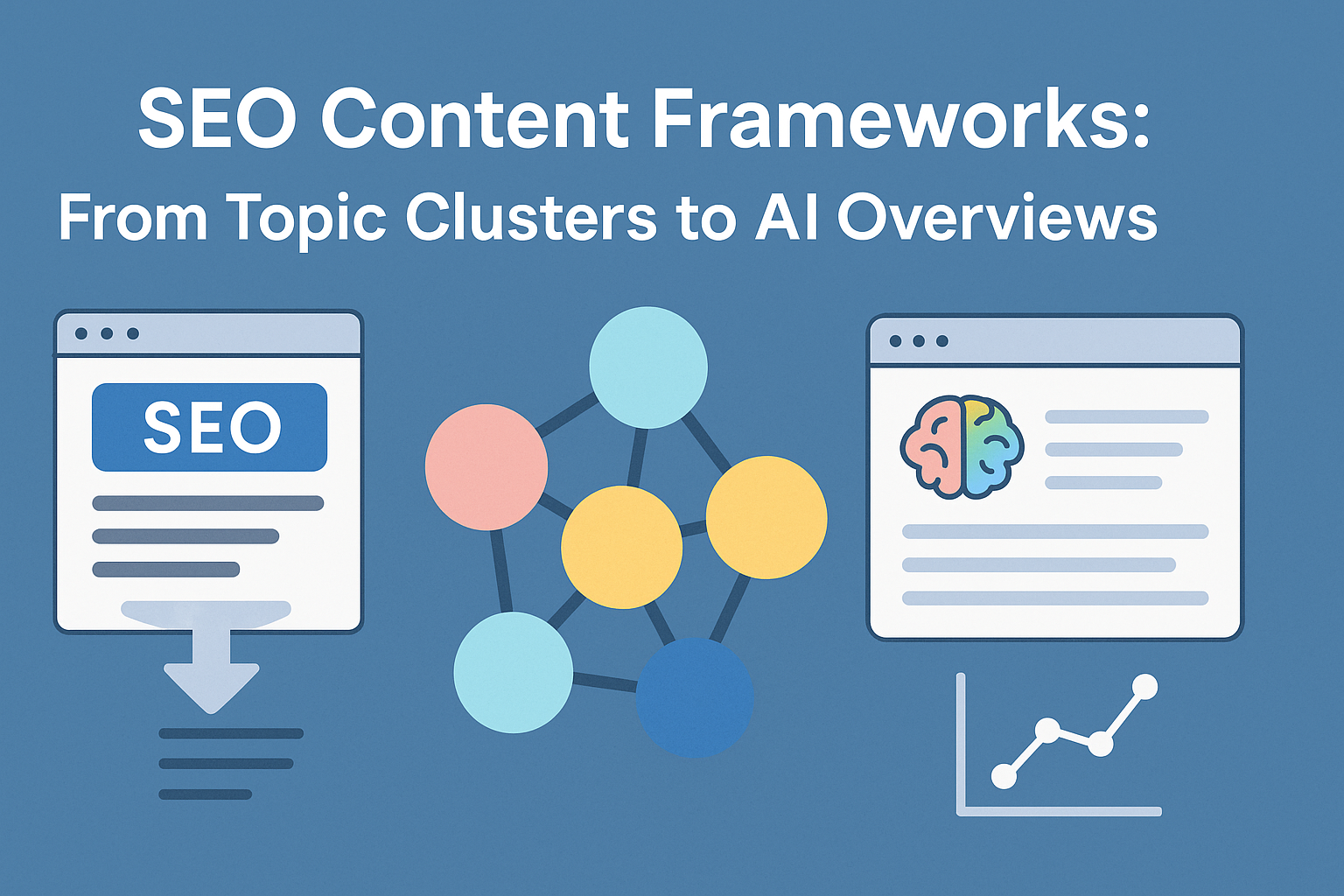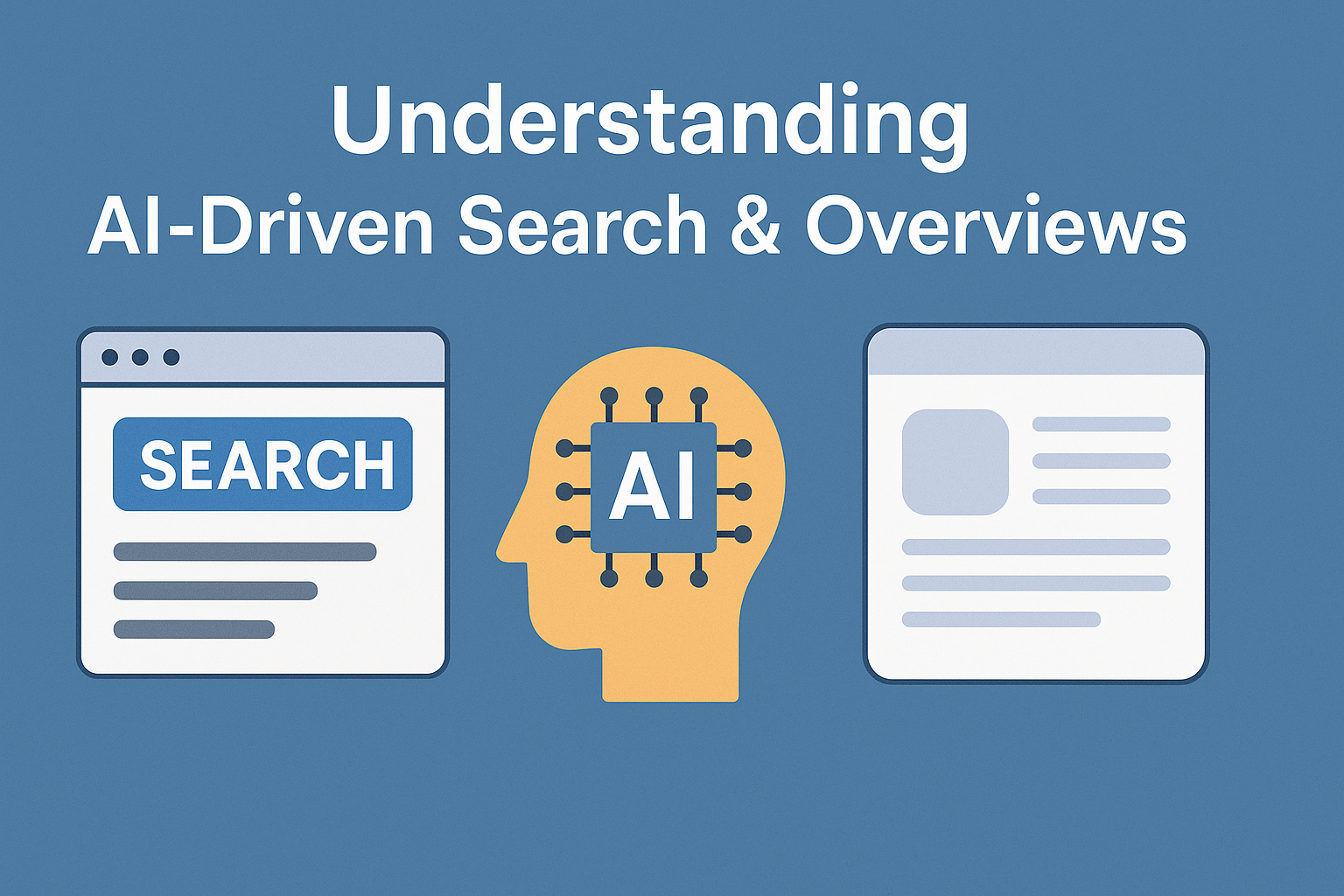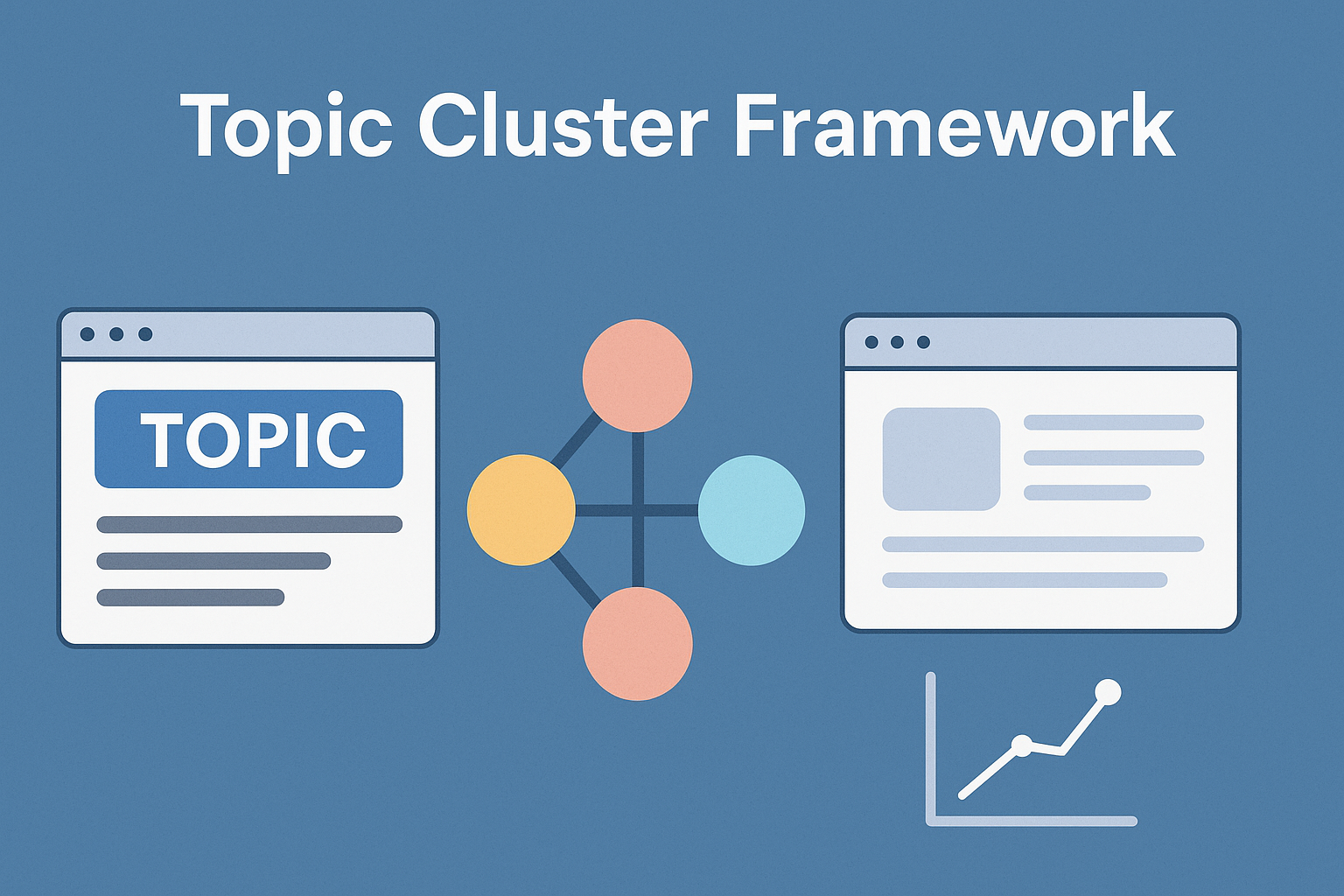SEO Content Frameworks

Search has never stood still. From the early days of keyword stuffing and backlink races to today’s era of structured, AI-enhanced discovery, the rules of visibility on the web have transformed beyond recognition. Yet one truth endures: content remains the cornerstone of every great SEO strategy.
But how we plan, connect, and optimise that content has changed dramatically. The old approach of publishing isolated blog posts is giving way to organised ecosystems built for both human understanding and machine interpretation. Enter the two frameworks shaping the next generation of SEO: Topic Clusters and AI Overviews.
Topic clusters provide the foundation — a method for structuring information around key themes to build topical authority. AI Overviews, meanwhile, represent the future — where search results are powered by generative intelligence, summarising the web rather than simply indexing it.
This blog explores both sides of that evolution. You’ll learn how to design topic clusters that establish credibility, how to optimise for the emerging AI search landscape, and how to integrate both into a single unified framework that drives sustainable growth.
What Is A Content Framework?
A content framework is a structured model that guides how you plan, create, organise, and optimise your website’s content. Rather than publishing random blog posts, you work from a deliberate system based on themes, internal linking, and hierarchy.
Why it matters
- Search engines now prioritise topic-based content that demonstrates expertise and authority, not isolated keyword-stuffed pages.
- Structured frameworks improve user experience—helping visitors move from general to specific content seamlessly.
- Strong frameworks make internal linking easier and distribute authority across your site more effectively.
- A clear content system is essential for aligning with AI-driven search, where structure and clarity affect machine understanding.
In short, a framework gives your SEO a scalable, strategic foundation—one that supports both human readers and search algorithms.
The Topic Cluster Framework: Concept, Benefits & How to Build It
What is a Topic Cluster?
A topic cluster is a network of related content organised around a single central idea. At the centre lies the pillar page—a comprehensive, authoritative resource on a broad topic. Surrounding it are cluster pages, which explore subtopics in detail.
For example:
- Pillar Page: “The Complete Guide to Digital Marketing”
- Cluster Pages: “SEO Strategy for 2025,” “Content Marketing for SaaS,” “Paid Advertising vs Organic Growth”
All these pages interlink—each cluster page links back to the pillar, and the pillar links to its clusters. This interconnectedness signals to search engines that your website covers the topic thoroughly.
Why Does It Matters for SEO?
- Topical Authority – Covering a subject comprehensively builds trust with both search engines and users.
- Improved User Experience – Readers can explore related ideas easily, reducing bounce rates and increasing engagement.
- Enhanced Internal Linking – Strategic linking spreads link equity and relevance, boosting overall site visibility.
- Semantic Search Alignment – Modern algorithms focus on meaning and context, not just keywords.
- Scalability – Topic clusters allow you to grow content in a structured, predictable way.
How to Build a Topic Cluster?
Step 1: Audit Existing Content
Inventory your current articles. Identify which can serve as pillars and which can become supporting clusters, while also noting any content gaps where new material is needed.
Step 2: Define Your Core Topics
Select a few major subjects that align with your brand and audience. These become your pillars—broad, high-value topics capable of supporting multiple subtopics.
Step 3: Identify Subtopics
For each pillar, brainstorm related themes that address specific user intents. For instance, a “Content Marketing” pillar might include clusters like “Video Content Strategy,” “Blog SEO,” and “Podcast Promotion.”
Step 4: Map Internal Links
Connect every cluster to its pillar using clear, descriptive anchor text. Where appropriate, cross-link between clusters to reinforce relevance.
Step 5: Create or Update Content
- Pillar pages should be long-form, comprehensive, and serve as the ultimate resource on a topic.
- Cluster pages should be in-depth and laser-focused on individual aspects.
- Maintain consistent formatting, voice, and tone across all pages.
Step 6: Monitor and Expand
SEO frameworks are living systems. Track performance, refresh content regularly, and add new clusters as trends evolve.

Internal Linking Best Practices
- Always link both ways: pillar → clusters and clusters → pillar.
- Use natural anchor text that matches user intent.
- Avoid creating dead-end pages.
- Maintain a visual map of your content architecture to ensure balance.
Common Pitfalls
- Creating a “pillar” without supporting content.
- Overlapping or redundant clusters.
- Ignoring user intent in favour of keywords.
- Neglecting to update older content.
By avoiding these traps, your topic cluster strategy becomes a sustainable, SEO-friendly framework.
Transitioning To The Age Of Ai: Understanding Ai-Driven Search & Overviews
The next major evolution in search is AI Overviews—a generative-AI-powered feature that summarises information directly in search results. Instead of just listing links, AI Overviews synthesise insights from multiple sources to answer a user’s question instantly.
What Are AI Overviews?
AI Overviews are intelligent summaries generated by search engines like Google, appearing above traditional organic results. They aim to provide concise answers and often cite the sources from which information is drawn.
How They Change SEO
- Reduced Click-Throughs – If users get the answer directly in SERP, fewer may visit your site.
- Visibility Shifts – Earning a mention in an AI Overview can drive credibility even if you’re not ranked first.
- Authority Becomes Crucial – AI models prioritise trusted, expert-driven content.
- Structure Matters – Well-organised, machine-readable content is more likely to be surfaced.
- Depth Wins – Shallow content rarely appears in AI summaries. Comprehensive coverage is key.
- Traffic Volatility – As AI Overviews evolve, organic clicks may fluctuate dramatically.
Optimising for AI Overviews
- Create Unique, Non-Commodity Content
Avoid rehashing generic information. Offer original data, expert commentary, or proprietary insights.
- Answer Questions Clearly
Structure your posts to include short, direct answers to common queries. Use headers that mirror real search questions.
- Use Structured Data
Implement schema markup (FAQ, How-to, Article) to help search engines understand your page’s structure and meaning.
- Target the Right Queries
Focus on intent-driven, specific questions rather than broad, over-competitive keywords.
- Strengthen E-E-A-T Signals
Showcase author expertise, cite credible sources, and include evidence of real-world experience.
- Keep Content Fresh
AI systems favour up-to-date information. Regular updates demonstrate relevance and reliability.
By preparing your content for both humans and machines, you can future-proof your SEO strategy for AI-enhanced search environments, especially as AI search becomes more dominant in user behavior.
Marrying Topic Clusters + AI-Optimised Content: A Unified Framework
Building topic clusters is the foundation; optimising for AI Overviews future-proofs it. The goal is to create content that’s both topically comprehensive and AI-friendly.
How to Integrate the Two
- Your pillar pages act as authoritative knowledge hubs.
- Each cluster page becomes a precise, question-driven article ready for AI summarisation.
- The entire network should be clear, logically linked, and technically optimised.
Structure for Both Humans and Machines
- Human-Friendly Layer – Narrative flow, examples, visuals, relatable tone.
- Machine-Friendly Layer – Structured headings, schema markup, bullet lists, concise definitions.
- Linking Layer – Strategic internal links that clarify relationships between concepts.
Technical & Content Recommendations
- Use schema for FAQs and How-to sections.
- Keep content modular—short paragraphs and sub-sections make it easier for AI to parse.
- Optimise metadata (titles, descriptions, headings).
- Add a clear “Quick Answer” box for common questions.
- Include updated stats or proprietary data where possible.
Example Workflow
Step 1: Topic Discovery
A health-and-wellness brand identifies “Healthy Eating for Busy Professionals” as its core pillar.
Step 2: Cluster Creation
Subtopics include:
- “5-Minute Meal Prep Ideas”
- “Healthy Office Snacks”
- “Reading Nutrition Labels Quickly”
- “Eating Healthy While Traveling”
Step 3: Content Creation
Each cluster becomes a detailed guide answering specific user intents, interlinked with the pillar page.
Step 4: Optimisation for AI Overviews
Each page includes a concise “Quick Answer,” structured headings, FAQs, and relevant schema.
Step 5: Monitoring & Refinement
Track rankings, engagement, and appearance in AI-driven search features. Update content quarterly.
Each page links back to the main pillar, forming a structured, intelligent web of content that AI systems can easily understand. This approach not only strengthens your topical authority but also ensures your content remains visible as search continues to evolve.
And while the rise of AI Overviews is transforming how information is delivered, some principles will never change. No matter how sophisticated search becomes, it’s essential to remember the fundamentals — the kind often covered in SEO Tips for Beginners: create clear, valuable, and well-structured content that genuinely helps people. These basics remain the backbone of every great SEO framework, even in an AI-driven world.
Practical Checklist & Metrics: How to Measure Success
Pre-Launch Checklist
- Keyword and topic research completed
- Clear outline and link map designed
- Unique content written with supporting visuals
- Internal linking implemented
- Schema markup added
- Meta tags optimised
- Mobile and speed tested
- Analytics configured
Key Metrics
- Organic Traffic – Track growth for each pillar and cluster page.
- Internal Link Clicks – Measure how users navigate between related pages.
- Engagement – Monitor time on page, scroll depth, and bounce rates.
- Rankings – Check both short- and long-tail keyword positions.
- Featured Snippets / AI Citations – Note any inclusion in AI Overviews or rich results.
- Conversion Metrics – Newsletter sign-ups, downloads, or form completions.
- Content Freshness – Track how often updates occur and whether performance improves afterward.
Consistent monitoring and optimisation ensure that your content ecosystem grows in strength and authority.

Final Thoughts
Search behaviour is evolving rapidly. AI-driven summarisation will continue to reshape visibility and engagement patterns. But these shifts don’t spell the end of SEO—they redefine it.
In the coming years:
- Structure and clarity will outweigh sheer keyword density.
- Topic authority will remain one of the strongest ranking factors.
- Human value and expertise will separate top-performing content from automated noise.
- Interactive and multimedia formats will gain prominence within search results.
- Analytics literacy will become essential—understanding not just what ranks, but why.
In short, the brands that win will be those that combine human creativity with AI-aware technical precision.




